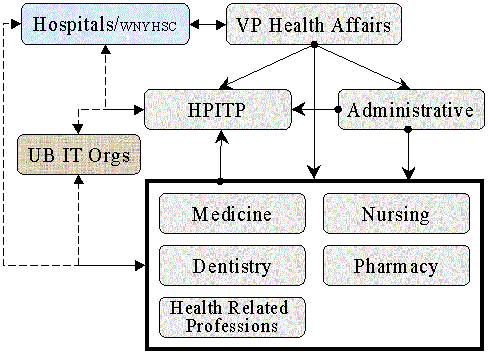5 schools, 43 departments and partners (HSL and 12+ Hospitals) ...
HSIT is an administrative arm of the office of the Vice President for
Health Sciences and the office of the Sr. Vice Provost for Educational
Technology. HSIT's charge is to serve as a tool for integrating Information Technology (IT) resources
across UB's Health
Science Schools, their affiliates, and other IT entities both within and
external to UB. HSIT exists to help our health sciences
professionals utilize IT in the realization of their various educational, research, community and
health care objectives.
In June of 1996, the deans of the five UB Health Profession schools signed a
memo of understanding agreeing to explore the possibility of consolidating their IT
support structures and of developing cross-curricular education offerings. The
'service venues' envisioned by the deans included ten specific areas: 1) - 5) the five
health professions schools, 6) the CHESC, 7) the Health Science Library, 8) the
educational 'points of contact' within Consortium hospitals (taken as a whole), 9) the
homes of faculty, staff and students and 10) selected distance learning venues.
In a separate effort during the same time frame, UB's Office of the Provost devised the
Educational Technology Action Plan (ETAP) to consolidate and improve the academic
Information Technology (IT) infrastructure at UB. The ETAP has divided the UB
academic landscape into IT functional units known as "nodes". The general
mission of these nodes is to assist in the development of their IT infrastructure and to
support the IT efforts and development of faculty, staff and students. Future IT funding
from the Provost’s office will be distributed through these nodes instead of
separately to individual schools. Information on the Provost's ETAP initiative is
available on the WEB at http://wings.buffalo.edu/provost/edtech/.
The Health Professions IT Partnership (HSIT) is the result of combining these two
initiatives. As envisioned by the deans, HSIT is charged with representing the five
Health Profession schools (Dentistry, Health Related Professions, Medicine, Nursing,
Pharmacy), the Health Sciences Library, and the teaching hospitals / related entities
comprising the Western New York Health Sciences Consortium. Due to the size and
diverse nature of HSIT’s constituents, it is easily the largest and most complex of
the Provost's nodes. HSIT is governed by a steering committee composed of the deans
of the five health science schools, the director of the Health Sciences Library, the
director of the Western New York Health Sciences Consortium, and the director of
HSIT. HSIT director's position was filled in November of 1997 and the director
reports to the Vice President of Health Sciences.
The individual schools within HSIT retain their existing IT support organizations and
these will serve as the primary points of contact in areas where they offer support.
HSIT will be working behind the scenes with these organizations to build
collaborations and partnerships among them. HSIT will also act as an independent
entity you can turn to for the resolution of service complaints. In other areas,
such as the services of the multimedia group, HSIT will play the role of a primary
service provider to all of the schools. If you are in doubt as to who should be
providing you with a particular service, please contact us and we'll track the answer down
for you. More details on HSIT current and future services can be found here.
If you're a HSIT constituent with specific interests, concerns or questions in
areas where IT may in some way benefit your unit's mission - I would appreciate the
opportunity of visiting with you to discuss them. Your concerns and interests cannot be
addressed if they go unstated. I look forward to working with you in the development
of a uniformly first rate IT infrastructure supporting IT savvy faculty, staff and
students in the years ahead. - Brian Murphy, HSIT Director; bwmurphy@buffalo.edu; (716)829-3172/829-3456 FAX.



